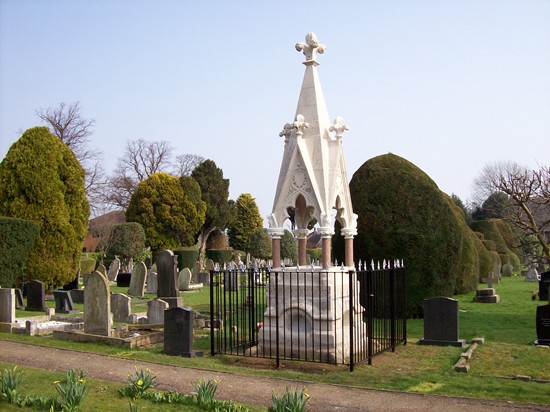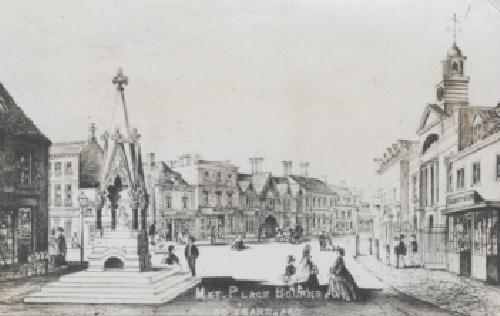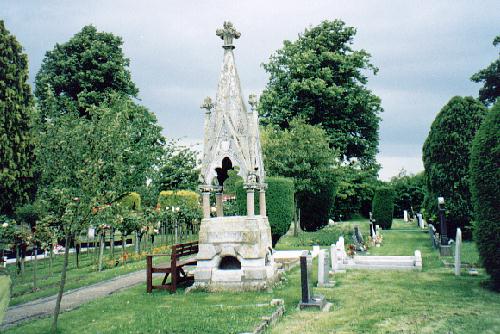|
John Lely Ostler 1811-1859
The ornamental
drinking fountain that stood in the market place at Bourne for a hundred years
was moved to a safe location in the town cemetery after being threatened by modern traffic flows. It was designed by Edward Browning and erected in 1860 as a memorial to one of the town's 19th century worthies, property owner John Lely Ostler, who had died the previous year, and paid for by public subscription and although his connection with the town was only a brief one, he must have been a man of some consequence to deserve such public recognition. John attended the grammar school for seven years before finishing his education at Oakham School in Rutland and on leaving, became a partner in his father's law firm. In 1849, he joined the town council and was elected mayor in 1851 and again in 1858 when he officiated at the unveiling of the statue to Isaac Newton that can still be seen near the town centre and was also one of the prime movers in the preparation of St Peter's Hill, a major town improvement scheme of the time, contributing his mayoral stipend towards the cost. He became a magistrate in 1855 and was a leading worker for charity, supporting many benevolent causes and acting as secretary to several religious societies including the Irish Church Missions to the Roman Catholics, the Foreign and British Bible Society and the Pastoral Aid Society. Ostler was also a major contributor to the various subscription lists launched to promote the welfare of the poorer classes. He moved to Cawthorpe with his wife Laura (1785-1864) only a short time before his death and his name can be found in the records of the Manor of Bourne in 1854 in connection with the purchase of Cawthorpe House, which he and his widowed mother, Mrs Lydia Ann Ostler (died 1869), were buying from John Hurn Dove. Between then and his death in 1859, he became one of the biggest land and property owners in Bourne. By 1856, he was a very rich man and White's Directory of Lincolnshire records that he had obtained possession of several properties, paying a total of £2,200 for his acquisitions. They included the site of the old coal yard, granary and sheds in Eastgate near the Fen Bridge which Ostler converted into a fellmonger's yard, dealing in skins and hides, and also the Maltings in West Street which had recently been enlarged by the addition of a foreman's dwelling house, together with the newly erected wine and spirit vaults and chambers, counting house, bottle house, timber sheds, saw pits and other buildings. He was also a dedicated Christian and while serving as a director and a principal shareholder of the Bourne and Essendine Railway Company he made himself responsible for looking after the moral welfare of the labourers employed on building the line by arranging for preachers to speak to them at meetings in the town and at the camps where they lived. At his
death, Ostler also left some cottages in Bourne and Dyke together with land at
Dyke and Dyke Fen. These properties were bequeathed to his son who, after
studying at Magdalen College, Oxford, was known to be working at the Audit
Office at Somerset House in London in 1865. John Ostler died on Monday 27th June 1859 at the age of 48. The first sign that he was ill came in a letter he sent to the Bourne auxiliary of the British and Foreign Bible Society, an organisation in which he took a deep personal interest, saying that he would be unable to take the chair at their meeting due to be held in the Town Hall that evening, Friday 10th June, although he had presided at a similar meeting in the Guildhall at Grantham two weeks before. Announcing his death, the Grantham Journal remembered his charity in these words: "Few persons have enjoyed the praises of his neighbours and fellow townsmen for the benevolent purity of his motives more than the deceased. All parties regarded the excellencies of his character with respect; and many a tear was shed by the poor and afflicted on his departure from Grantham to his new residence at Cawthorpe House, near Bourne. His record is on high and his memory will be cherished with affection and regard, not only by the more immediate circle of his intimate friends, but by all those who have witnessed his godly simplicity and sincerity of purpose, and admired his deeds of charity and Christian love." The Stamford Mercury reported on Friday 1st July: "He was a great supporter of the missionary cause and a liberal donor to all charitable institutions, especially schools. The rich and the poor have lost a valuable and sincere friend. His remains are to be interred at Bourne this day. A large number of relatives and friends from Grantham will assemble to witness the last ceremony that can be performed on earth for so good a man." The high esteem in which he was held is also reflected in the report of his funeral carried by the Stamford Mercury on Friday 8th July: Although Mr Ostler had only very recently taken up his residence at Cawthorpe, he had become very generally respected by the inhabitants of Bourne and the neighbourhood, as was testified on Friday last by between 50 and 60 of the principal inhabitants (accompanied by several gentlemen from Grantham), meeting the funeral cortege at the north end of the town and then walking in procession to Bourne cemetery to witness the last ceremony towards one in whose death both rich and poor have lost a valuable and sincere friend. The shops in the streets through which the funeral passed were all closed. During the last few years, Mr Ostler has made several purchases of property in the neighbourhood, and in the course of that time he has undoubtedly been the means of doing much good. Amongst other things, he was the proprietor of the Bourne and Essendine lines of railway, for the successful carrying out of which he was untiring in his exertions. He was mainly instrumental in the establishment of the Bourne Water Works (upon land belonging to him at the north end of the town), and he also gave land upon which is built the Infant schools, in the Eastgate, in addition to a handsome donation towards the erection of those schools, besides supporting several local associations for benevolent and religious objects. By all parties the excellencies of his character were regarded with respect, and by the more immediate circle of his intimate friends his memory will be cherished with affection. The bulk of his estate holdings in Dyke and Bourne were offered for sale by auction at the Angel Hotel on 9th December 1861 but the bidding was not enthusiastic and only one lot was sold although the remainder were disposed of afterwards by private treaty. Among them was Bourne House in West Street, then occupied by Mr J L Bell, the solicitor, who bought it as a sitting tenant for £800 despite a reserve of £1,100. A trade directory of 1870, published eleven years after his death, also records that: "The Abbey vicarage is in the gift of the executors of J L Ostler". It was this benevolence that was probably responsible for the remarkable success of the public subscription to finance the memorial because the money to pay the bill, a total of £120, was raised within seven months. The memorial chosen was a water fountain to be erected in the market place, a fitting tribute because of Ostler's part in bringing piped water to the town with the formation of the Bourne Waterworks Company in 1856 and their first borehole was sunk on land that he had provided in what is now North Road. A special committee of seven gentlemen was appointed to handle the project at a meeting held at the Angel Hotel on Tuesday 19th July. The Stamford Mercury reported the following Friday: The public fountain will be erected with the double object of commemorating the memory of the late John Lely Ostler Esq and promoting the welfare of the poor. The meeting was very respectably attended and a unanimous feeling of respect for the memory of Mr Ostler, that gentleman having been mainly instrumental in the establishment of the Bourne Water Works (which are a source of great benefit to the inhabitants of the town), it was thought that a drinking fountain which should be made sufficiently ornamental to be worthy of the object in view, would be a very appropriate manner of commemorating his memory. The opinion of the meeting was that the most eligible site for the erection of the fountain was near the road side, opposite the centre of the Town Hall. The committee agreed to obtain designs, estimates and costs for the edifice and subsequently invited tenders for the completion of the work. The members met again in January 1860 to consider the six that had been received, the highest being £177 from a London firm and the lowest £105 from Messrs John and James Sneath, builders and bricklayers of Baston, who were subsequently awarded the contract and began work immediately although their final bill was agreed at £120 (almost £6,000 at today's values). Edward Browning, who was commissioned to design the memorial, lived at Thurlby and had sound local credentials because his father Bryan Browning (1773-1856) had been an architect of some repute with premises in Broad Street, Stamford, and he designed the Town Hall at Bourne in 1821 and the House of Correction at Folkingham in 1825. His son Edward (1816-1882) continued his father's work and was responsible for the design of the Town Bridge over the River Welland at Stamford in 1849, much renovation work on local churches including Bourne Abbey and the design of the chapel in the town cemetery in 1855. The stone was carved by Mr William Hilliam of Stamford, a stonemason of some repute locally and who was described by the committee as "a clever carver."
The edifice built of Portland stone consists of a canopy supported on four shafts of Aberdeen granite and with four base steps made of Yorkshire stone and a jet of pure water continually falling into an ornamental basin. It was finally unveiled during a public ceremony in October 1860 and the Stamford Mercury reported on Friday 19th October 1860:
A
drinking fountain has been erected in the Market Place at the
junction of four thoroughfares. It perpetuates the memory of the
late John Lely Ostler Esq, a gentleman deservedly esteemed for his
extensive benevolence whilst resident in this locality. The height
of the monument is 18 feet 6 inches, including three steps of
Yorkshire stone by which it is approached. On each of the four
sides is a dog trough in a segmental-headed recess into which
flows a continuous stream of water, the surplus passing away
immediately below the rim of the basin, through a pipe into the
interior of the fountain. A jet in the form of a lily will supply
water for the use of thirsty wayfarers, the surplus falling into a
quatrefoil basin having small proportions. The supply of the
precious fluid has been so arranged that none of it can be
obtained for domestic purposes; it is generously given by the
Waterworks Company who dispose of their water at an extremely
cheap rate to the inhabitants.
The
sides above the conduit, which are open, consist of four
cinquefoil-headed arches under pedimental canopies supported by
shafts of red-polished granite. From the centre rises a spire
terminating in a foliated finial. At the angles, from which the
canopies spring, are the evangelistic symbols, viz. St Matthew's
angel, St Mark's winged lion, St Luke's ox and St John's eagle. In
the centre of the triangular space above each arch is a blank
escutcheon set in a circle, the other part of the spandrel being
filled with examples of the thorn, ivy, maple, buttercup,
wheatear, hazel, ground ivy, convolvulus &c. Each apex is
crowned by a foliated finial, reaching midway up the spire. Round
the four sides, below the central basin, is a label containing
this inscription: "This fountain was erected by subscription
for the use of the public in memory of John Lely Ostler, Esq, late
of Cawthorpe House, 1860". The monument is of Portland stone and is a facsimile of a style of architecture that prevailed in this country in the 14th century, known as Decorated or middle pointed; the foliated capitals of the shafts are examples of the previous (Early English) style. The working of the fountain was sporadic, despite repeated attempts at maintenance, and in 1874 it ceased to function altogether but was repaired the same year and the bill paid with income from the Bourne Constables' Land Charities. In 1888, it again stopped working and the Stamford Mercury commented on 17th August that it should either be removed or utilised for its original purpose, such as the watering of cattle. The following week, the newspaper reported: We are informed by one of the directors of the Water Company that, when erected by public subscription some years since, the fountain was furnished with simple provision for the purpose we suggested. The watering troughs for animals were however, rendered completely useless by downright wanton mischief. The police authorities who (our informant tells us) were frequently appealed to, treated the affair with indifference and took no steps whatever to protect the property. The fleur-de-lis which ornamented the angles of the drinking fountain were mutilated. The pipes were filled with stones and dirt so that the water ran over into the Market Square and became a nuisance. Naturally, under such circumstances, the Water Company discontinued the supply. These occurrences are to be regretted. As the structure still stands, we would repeat our suggestion that the fountain be utilised for drinking purposes and for watering cattle. We have confidence that if the company would once more make the experiment, it would meet with hearty public approval and the police authorities would be more energetic in preventing wanton destruction of public property than apparently were their predecessors. A
century after being built, the fountain had outlived its usefulness and the
purpose for which it had been erected was largely forgotten. New safety
precautions were being introduced in the town centre because of increasing
traffic flows, including an experimental roundabout, improved vehicle lanes,
widened pavements and a pedestrian crossing, all approved by the Ministry of
Transport, Kesteven County Council and the police, but the fountain did not
feature in these plans, other than for its removal. In July 2007, the fountain was given a Grade II listing by the Department of Culture, Media and Sport (DCMS) on the recommendation of English Heritage. During the listing procedure, English Heritage decided that the memorial was at risk and needed renovation and Bourne Town Council subsequently agreed to spend £9,000 on restoration which included £6,000 from the cemetery development fund and a £3,000 grant from Lincolnshire County Council. The restoration was completed in March 2009 when iron railings were installed around it as part of the project, an addition which was regarded by many conservationists as an intrusive feature and one that formed no part of the original design and looked rather incongruous although time has given them an acceptable permanence.
See also Hidden secrets of the Ostler memorial The Ostler memorial in past times Cawthorpe The Eastgate School The Railway Navvies Water supplies
Go to: Main Index Villages Index |




